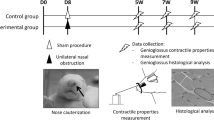Abstract
Objective
The objective of this study was to investigate the effects of chronic intermittent hypoxia (CIH) on genioglossal ultrastructure and mitochondrial function as well as the intervention role of adiponectin (Ad).
Methods
Forty-two Wistar rats were randomly divided into three groups with 14 rats in each. Rats in group A were kept breathing normal air, while rats in both groups B and C received the same CIH environment (a 2-min cycle, 1 min on, 1 min off with a nadir O2 at 4–5%, 8 h/day for successive 5 weeks). However, rats in group C was given regular intravenous Ad injection (10 μg per time, twice a week for successive 5 weeks). A simultaneous intravenous injection of saline (0.5 ml per time) was carried in groups A and B. At the end of experiment, the genioglossal ultrastructure, the serum adiponectin levels, the mitochondrial membrane potential (ΔΨm), and activities of respiratory chain complexes I and IV in mitochondrion of genioglossal cells were compared among groups.
Results
Serum Ad level was significantly lower in group B than that in group A (P < 0.01). In group B, there were genioglussal myofibril discontinuities, lysis of myofilament, edema of mitochondria, and disruption of cristae, vacuolus, and lysis of some mitochondria. These pathological changes were less significant in group C. The relative value of ΔΨm was the lowest in group B but the highest in group A (P < 0.01), with group B in between. The concentrations of mitochondrial complexes I and IV in group B were the lowest but became higher and higher from group C to A, with a significant difference among groups (all P < 0.05).
Conclusion
CIH could lead to hypoadiponectinemia, impaired genioglossal ultrastructure, and mitochondrial dysfunction. These changes could be improved by supplement of Ad.


Similar content being viewed by others
References
Oliven A, Tov N, Geitini L, Steinfeld U, Oliven R, Schwartz AR, Odeh M (2007) Effect of genioglossus contraction on pharyngeal lumen and airflow in sleep apnoea patients. Eur Respir J 30(4):748–758
Carrera M, Barbé F, Sauleda J, Tomás M, Gómez C, Agustí AG (1999) Patients with obstructive sleep apnea exhibit genioglossus dysfunction that is normalized after treatment with continuous positive airway pressure. Am J Respir Crit Care Med 159(6):1960–1966
Zhang XL, Yin KS, Wang H, Su S (2006) Serum adiponectin levels in adult male patients with obstructive sleep apnea hypopnea syndrome. Respiration 73(1):73–77
Masserini B, Morpurgo PS, Donadio F, Baldessari C, Bossi R, Beck-Peccoz P, Orsi E (2006) Reduced levels of adiponectin in sleep apnea syndrome. J Endocrinol Investig 29(8):700–705
Vatansever E, Surmen-Gur E, Ursavas A, Karadag M (2011) Obstructive sleep apnea causes oxidative damage to plasma lipids and proteins and decreases adiponectin levels. Sleep Breath (in press)
Chen L, Einbinder E, Zhang Q, Hasday J, Balke CW, Scharf SM (2005) Oxidative stress and left ventricular function with chronic intermittent hypoxia in rats. Am J Respir Crit Care Med 172(7):915–920
Santos DL, Moreno AJ, Leino RL, Froberg MK, Wallace KB (2002) Carvedilol protects against doxorubicin-induced mitochondrial cardiomyopathy. Toxicol Appl Pharmacol 185(3):218–227
Gornall AG, Barwill CI, David MM (1949) Determination of serum proteins by means of the biuret reaction. J Biol Chem 177(2):751–766
Fujita S (1993) Obstructive sleep apnea syndrome: pathophysiology, upper airway evaluation and surgical treatment. Ear Nose Throat J 72(1):67–72
Halestrap AP, Doran E, Gillespie JP, O’Toole A (2000) Mitochondria and cell death. Biochem Soc Trans 28(2):170–177
Ceddia RB, Somwar R, Maida A, Fang X, Bikopoulos G, Sweeney G (2005) Globular adiponectin increases GLUT4 translocation and glucose uptake but reduces glycogen synthesis in rat skeletal muscle cells. Diabetologia 48(1):132–139
Yoon MJ, Lee GY, Chung JJ, Ahn YH, Hong SH, Kim JB (2006) Adiponectin increases fatty acid oxidation in skeletal muscle cells by sequential activation of AMP-activated protein kinase, p38 mitogen-activated protein kinase, and peroxisome proliferator-activated receptor alpha. Diabetes 55(9):2562–2570
Griendling KK, FitzGerald GA (2003) Oxidative stress and cardiovascular injury: part I: basic mechanisms and in vivo monitoring of ROS. Circulation 108(16):1912–1916
Murphy MP (2009) How mitochondria produce reactive oxygen species. Biochem J 417(1):1–13
Prior SL, Tang TS, Gill GV, Bain SC, Stephens JW (2011) Adiponectin, total antioxidant status, and urine albumin excretion in the low-risk “Golden Years” type 1 diabetes mellitus cohort. Metabolism 60(2):173–179
Chevillotte E, Giralt M, Miroux B, Ricquier D, Villarroya F (2007) Uncoupling protein-2 controls adiponectin gene expression in adipose tissue through the modulation of reactive oxygen species production. Diabetes 56(4):1042–1050
Acknowledgment
This study was supported by Nantional Natural Scientific Funding of China (30971167).
Author information
Authors and Affiliations
Corresponding author
Rights and permissions
About this article
Cite this article
Huang, H., Zhang, X., Ding, N. et al. Effects of chronic intermittent hypoxia on genioglossus in rats. Sleep Breath 16, 505–510 (2012). https://doi.org/10.1007/s11325-011-0532-y
Received:
Revised:
Accepted:
Published:
Issue Date:
DOI: https://doi.org/10.1007/s11325-011-0532-y




